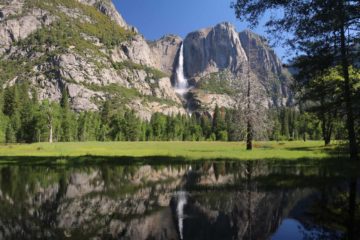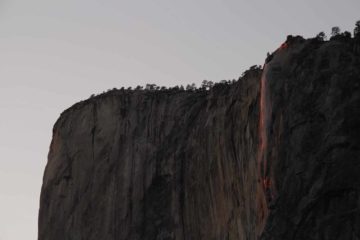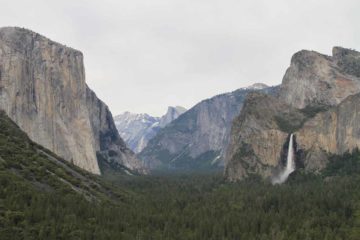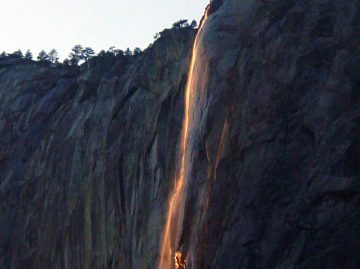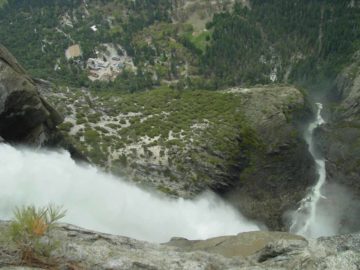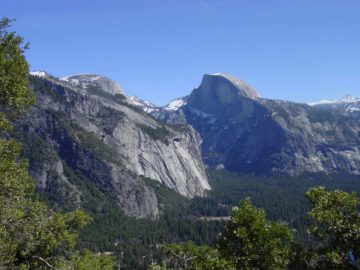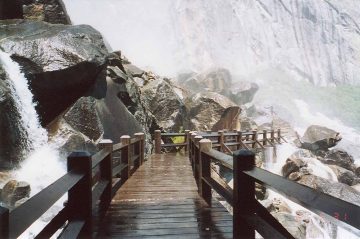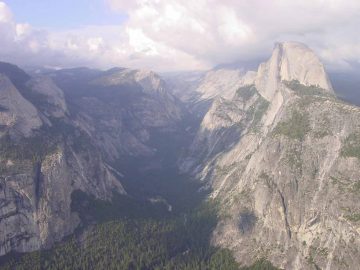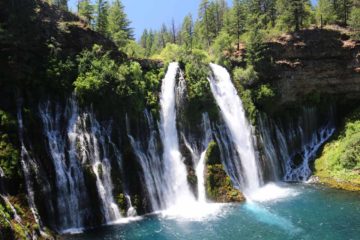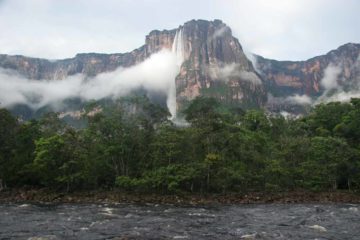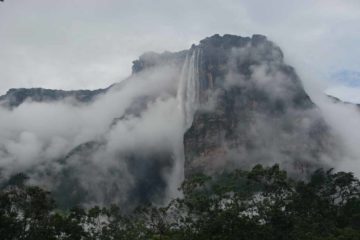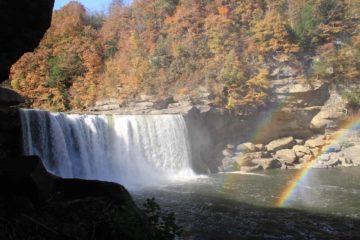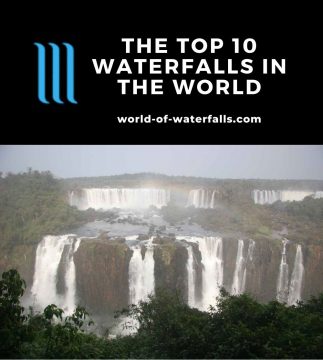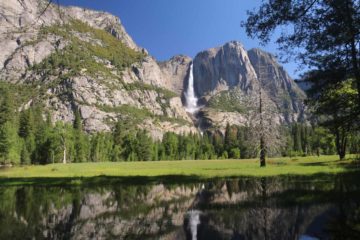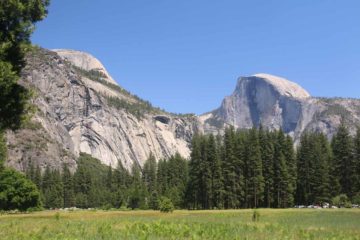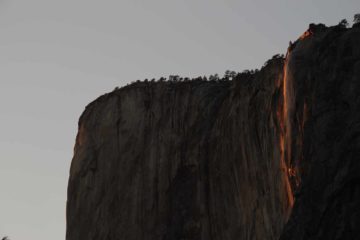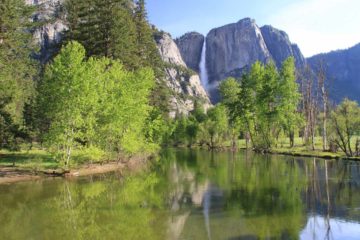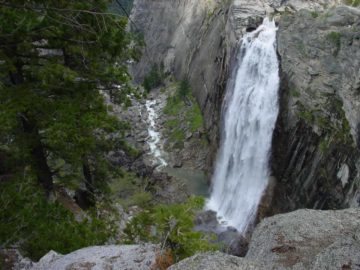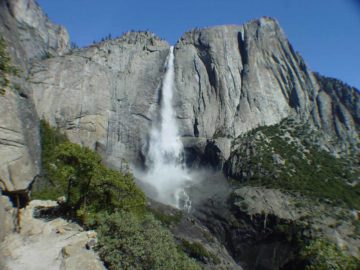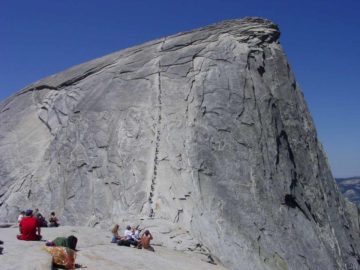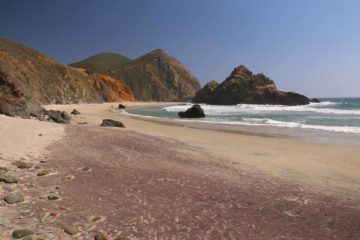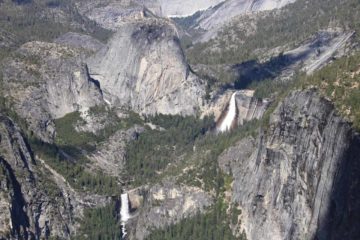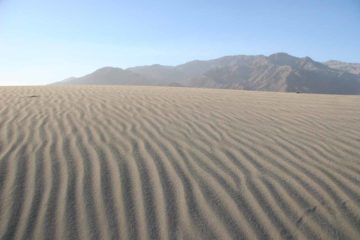About Yosemite Falls
Along with Half Dome, Yosemite Falls is the iconic symbol of the grandeur and beauty of Yosemite National Park.
We think the falls is practically synonymous with the incomparable Yosemite Valley, and for something this grand and beautiful, we had to put the falls in both our Top 10 Waterfalls of the USA List and our Top 10 Waterfalls of the World List.
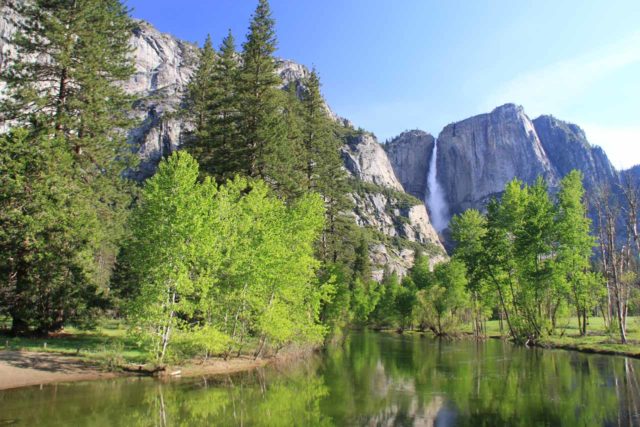
The Historical Significance of Yosemite Falls
I had read that Yosemite Falls had featured on early drawings made by Thomas Ayres, which then found their way into print.
Consequently, that popularized and attracted tourists from across the country in the latter half of the 19th century.
With such a ground swell of visitation and interest, this established the chain of events that would ultimately result in The Yosemite becoming a California State Park in 1864.
It was the first such act of government of its kind, where land was set aside for public use and enjoyment.
Thus, I have to believe that the historical significance of the falls was such that it could very well have been the catalyst that sparked the conservation movement.
It was also the model by which the eventual protection of lands and whole ecosystems would manifest themselves in reserves that would eventually be known as National Parks eight years later.
Attributes of Yosemite Falls
Yosemite Falls drops in three major stages.
The first stage is the Upper Fall, which is said to plunge 1,430ft.
The second stage is the Middle Cascades, which tumbles down a height of reportedly 675ft.
The final stage is the Lower Fall, which is said to drop 320ft.
Thus, Yosemite Falls is widely reported to have a cumulative drop of 2,425ft making it one of the highest waterfalls in the world.
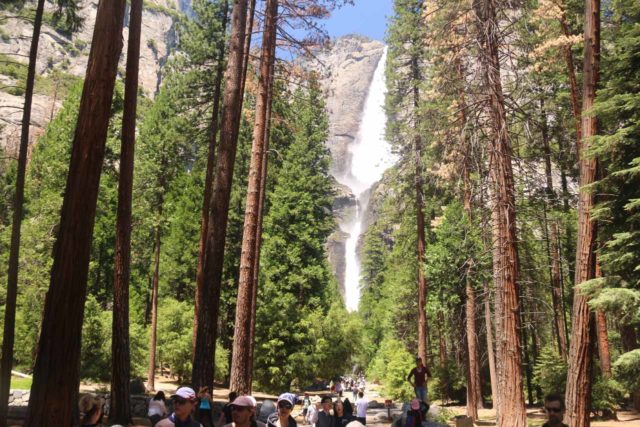
Since the falls faces out towards a wide open valley, it also happens to be one of the easiest waterfalls to both see and access.
I think it’s this accessibility coupled with its immense beauty that makes Yosemite Falls a world class tourist attraction in a place that is full of them!
Indeed, we were able to see some or all of the waterfall from various locations throughout Yosemite Valley both from within the valley itself and from the rim of the valley in the High Country.
Yosemite Falls and the Seasons
Yosemite Creek, which feeds the waterfall, drains a very large area of the High Country (reportedly 43 square miles).
Generally, snow pack accumulated from Winter storms provide the falls most of its water. The water would remain locked up as snow and ice until the warmer climate of Spring and early Summer converts all that solid water into liquid water.
The falls flows most vigorously during the Spring snow melt.
We’ve seen the peak of this snowmelt occur as early as the early- to mid-Spring months during low snow pack years. On the other hand, we’ve also seen the peak of the snowmelt occur as late as June in high snow pack years.
Yet despite the large drainage area feeding Yosemite Creek, the waterfall does dry up when its snow pack has completely melted away (which typically occurs by mid- to late Summer).
Then, the falls remains bare until the next round of significant storms in the late Autumn or Winter months brings it back to life and repeats this cycle.
The Various Ways to experience Yosemite Falls
Over the years, we’ve photographed this waterfall too many times to count. So naturally, we have lots more photos of Yosemite National Park’s crown jewel that we’d like to share with you, which are shown in the photo journal tab towards the bottom of this page.
We’ve experienced the falls in a variety of ways, and in this page, we’ll break down all the ways that we’ve done it.
You’ll see that each way of experiencing Yosemite Falls is different.
We think it’s worth doing as many of these as you can, because you’ll automatically visit parts of Yosemite National Park that you might not have considered otherwise.
And thus you’ll gain a better appreciation of your time spent in Yosemite in addition to a better appreciation of the waterfall itself.
Base of Yosemite Falls
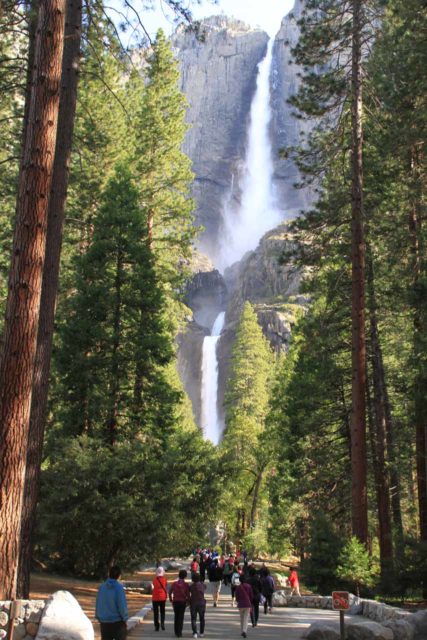
This is the most straightforward way of getting close to the waterfall.
The walk begins right across the Northside Drive from Yosemite Lodge.
It’s pretty much paved almost the entire way so there’s even wheelchair access to see the lower waterfall.
There’s a footbridge providing great open views of the lower waterfall.
But what we enjoy most about seeing the falls this way is the view of both Upper and Lower Yosemite Falls from the paved walkway.
To see the giant waterfall framed by tall trees flanking the walkway is truly a sight to behold, and we frequently find ourselves taking photos almost every step of the way.
Proceeding further along the walkway, our grand view of the full height of the falls eventually gives way to just the lower waterfall as the views of the upper waterfall become blocked.
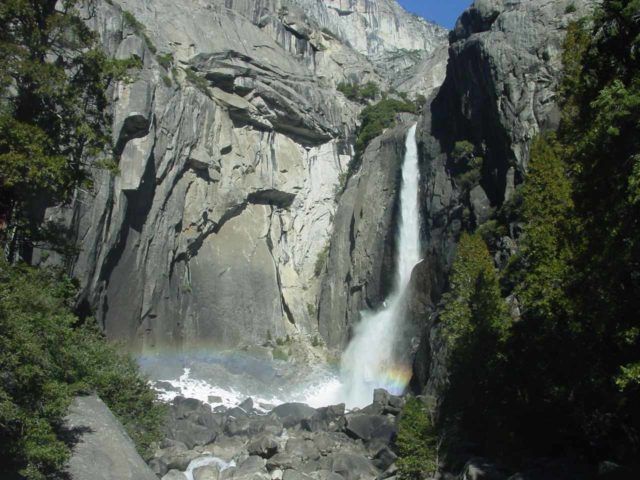
Although there’s a path leading from the east at the other side of the footbridge at the lower waterfall, it’s not as atmospheric as the direct path from Yosemite Lodge.
You just don’t get to see the entire waterfall together as much as you would if you did it the way I’m advocating. However, you would access the Yosemite Visitor Center going that way.
So given the fact that this super easy walk lets just about anyone get up close to the mighty Yosemite Falls, we found ourselves sharing this waterfall with people at all times.
Indeed, you’re most likely not going to have neither this trail nor the falls to yourself.
That said, this waterfall alone could induce many more people to become a lover of waterfalls like us. And that’s not a bad thing!
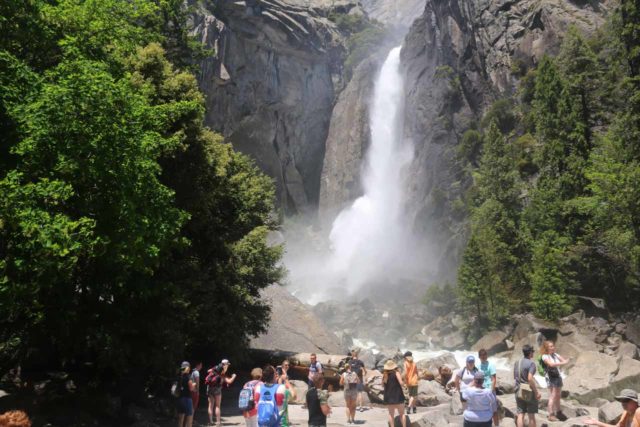
As for logistics, there used to be a car park on the north side of Northside Drive, but now it’s pedestrians only.
These days, there’s day use parking lot behind Yosemite Lodge with other car park locations by Curry Village as well as Yosemite Village (both further to the east).
There’s also pullouts alongside Northside Drive and some of the intermediate roads since parking was not easy to find, especially in the Summer months and on the weekends.
If parking near the falls isn’t successful, there’s generally some parking space at Curry Village (signpost V22 in the eastern end of the valley). Then, you can take the shuttle bus towards Yosemite Lodge.
And if that’s not successful, then you’d have to resort to trying to find roadside parallel parking wherever you can.
The Yosemite Road Guide says the wheelchair-friendly pedestrian path is by signpost V3 (or is it V4?). That said, I don’t remember if that signpost is still there as this area has seen quite a transformation over the years to alleviate the crowds and traffic congestion.
The Top of Yosemite Falls (Difficulty: 4.5)
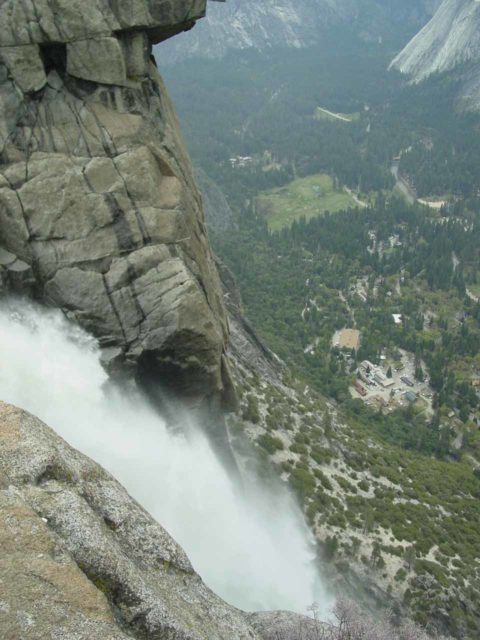
We definitely had to be in pretty good shape in order to experience the waterfall in this manner!
Just the fact that it was a long and tiring hike with some serious elevation gain made us appreciate just how tall this waterfall really was!
All told, we ended up doing about 7.2 miles round trip with about 2,700ft of elevation gain.
Most of the walk was exposed to the sun since it was on the south-facing cliffs of Yosemite Valley.
So we definitely needed to bring lots of water, stamina, and sunscreen.
I’d recommend getting an early start especially if you’re doing this hike on a relatively warm day. My mom and I once started this hike in the early afternoon, and it was almost dark by the time we finished.
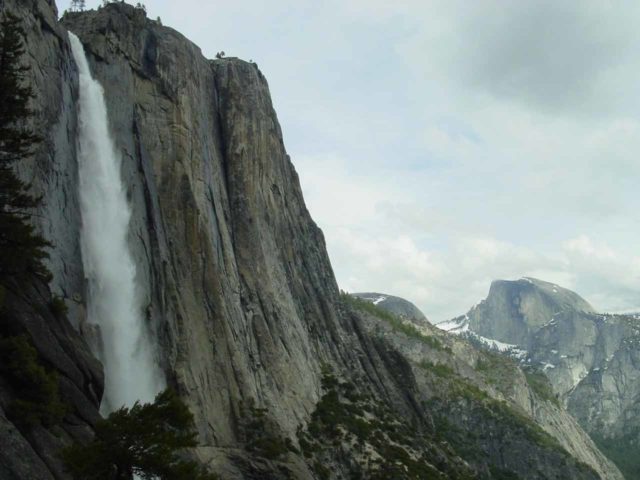
And to underscore how strenuous this hike was, there were moments of self-doubt as I was battling leg cramps before reaching the destination.
Given the relentlessly uphill climb we had to make, in addition to all the aforementioned things about coming prepared, it would also be wise to take your time and listen to your body.
Especially pay attention when it starts to complain about something.
The trail began behind Camp 4 (also known as the Sunnyside Campground).
This camp was well known in the rock climbers circle (because it’s where you’d base yourself for a climb up El Capitan’s vertical face) as well as park veterans (because it’s a walk-in campground).
It was about a 1/4-mile west of the walkway to Lower Yosemite Falls.
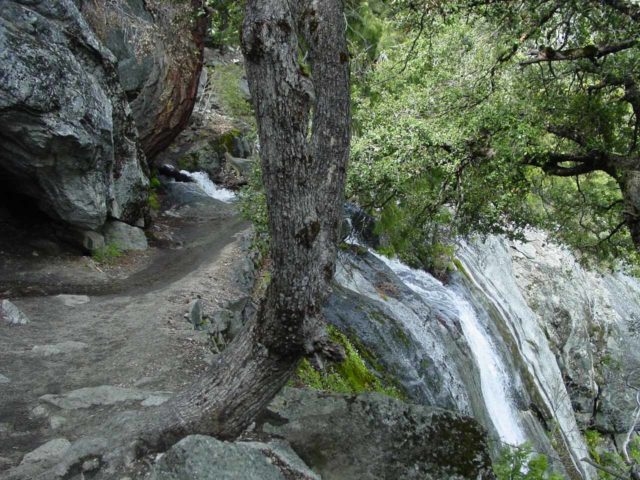
Since we couldn’t conveniently park in Camp 4 unless we somehow secured a camping spot there, we had to count that extra 1/4-mile distance as part of our hike.
I suppose if we really wanted to save that extra 1/2-mile round trip distance between trailheads, we could’ve waited for a shuttle to drop us off at the Sunnyside Campground one stop beyond Yosemite Lodge.
The Yosemite Road Guide had the trailhead near signpost V5.
Once we found the correct trail, it almost immediately climbed up in earnest. This climb persisted until we got up to the Columbia Point Lookout at about the 1.2-mile point.
During this stretch, we had to cross the stream coming from “El Capitan Falls“, which I’d imagine only persisted during high snowpack/snowmelt years.
When we did this hike in April 2005, which was an unusually high snowpack year, that crossing presented a mild slip-and-fall dropoff hazard.
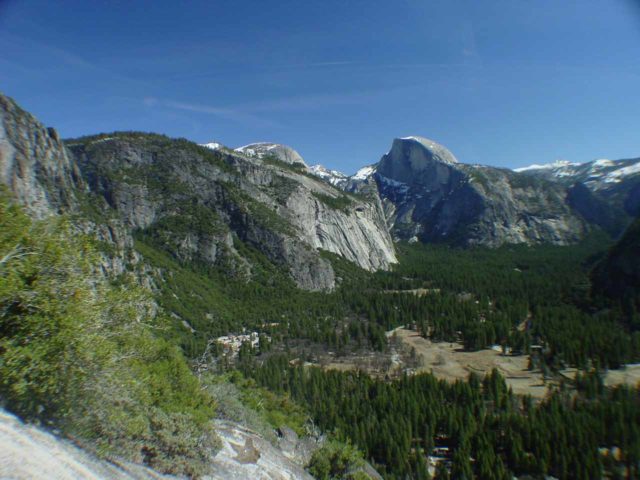
In any case, once we were at the Columbia Point Lookout, we were able to take a short break while looking down at Yosemite Valley, across at Sentinel Rock and Sentinel Falls, and further east towards Half Dome.
For many people, this would be a suitable turnaround point (making it roughly under 4 miles round trip). But if you’re going to the top of Yosemite Falls, then there’s still quite a ways to go!
Next, the trail went up a grueling set of switchbacks on a sandy surface before leveling out.
That sandy surface lacked enough traction that for each step we took, we would slide a short distance downhill. So we didn’t gain all the uphill distance for each stride we took (making this already strenuous stretch even more brutal).
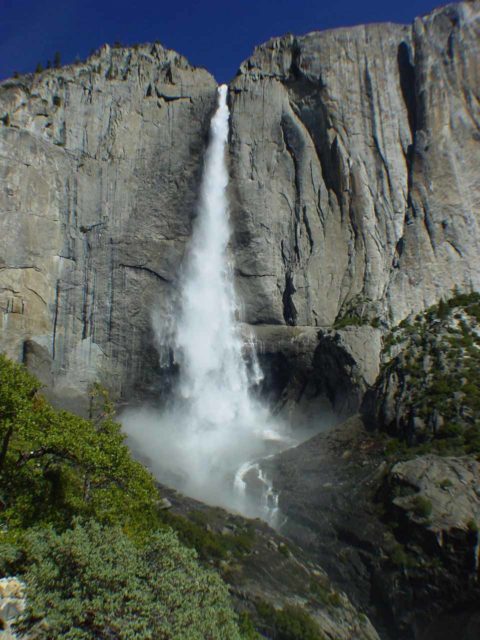
The trail then made a turn and headed closer to the Upper Yosemite Falls. It was from this stretch of the trail that we managed to get a closer look at the Middle Cascades.
By the time we got right up to the rock wall nearly adjacent to the plunge of the Upper Yosemite Falls, we had to go up yet another series of long granite steps and switchbacks.
I’d consider this part the most grueling stretch of hiking since it was basically a non-stop ascent on the unforgiving granite surface. I recalled even cramping up towards the end of this stretch.
Ultimately, the trail reached the top where it junctioned with some high country trails. During our April 2005 hike, this area was still under snow. Fortunately, we spotted signposts that directed us to keep right and follow that trail to the top of the falls.
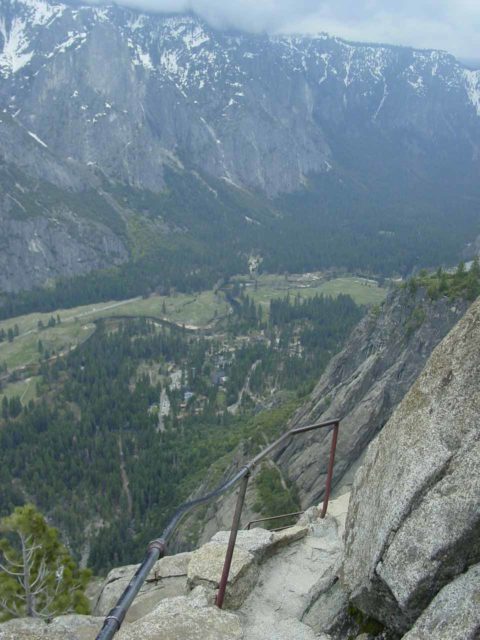
Right near the top of the falls, we did have to face some mild cliff exposure, which tested our fear of heights.
That said, there were some railings to help reassure us.
Yet despite the infrastructure, we were still getting some butterflies, especially near the cliff edges at some of the more exposed parts of the trail.
I guess such sensations were our body’s natural reaction to the threat of falling, especially since it was a long way down!
View from Swinging Bridge

This is probably one of my favorite vantage points for photographing Yosemite Falls.
That’s because we were able to see the falls reflected in the Merced River from a sturdy footbridge (totally not indicative of its name) as well as a more direct view from a spot just east of the bridge.
We’ve generally found that the river was most calm with the most favorable lighting in the morning.
The car park for this spot is at signpost V17.
This is a couple of stops after Bridalveil Fall and one stop after the bottom of the Four Mile Trail (to Glacier Point), which is also a spot to see Sentinel Falls.
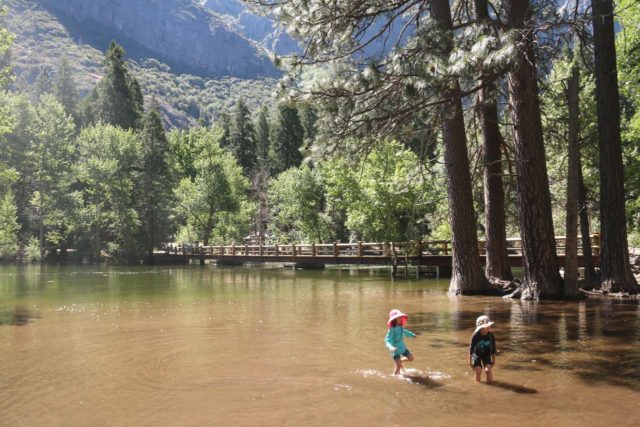
After parking the car, we walked a short distance to the swinging -err sturdy bridge.
On the other side of the bridge, there were trails following the north banks of the Merced River and eventually leading to the Northside Drive.
But not far to the east side of the bridge was a shallow part of the river where the kids really enjoyed cooling off and playing in the water.
Indeed, there were many ways to spend time enjoying this beautiful spot, and it’s understandable why the parking area here can fill up quickly.
Yosemite Falls seen from across a Meadow
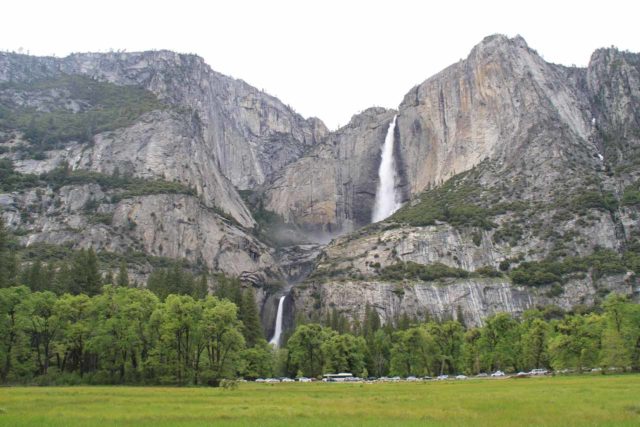
This is probably one of the more obvious ways to view Yosemite Falls.
As you drive along the Southside Drive past the pullouts for the Four Mile Trail and Swinging Bridge, the valley opens up and parallels a long pullout and bike path near signpost V19 (according to the Yosemite Road Guide).
Given the size of this pullout, there’s plenty of space and time to pull over here.
I believe somewhere near the end of this stretch (not far from the Yosemite Chapel, I recall), there’s a bridge crossing over the Merced River leading to another large pullout with more views of both Upper and Lower Yosemite Falls from across Cook Meadow (see photo above).
Beyond this car park, I believe the road continues into Yosemite Lodge as well as connecting with the Northside Drive.
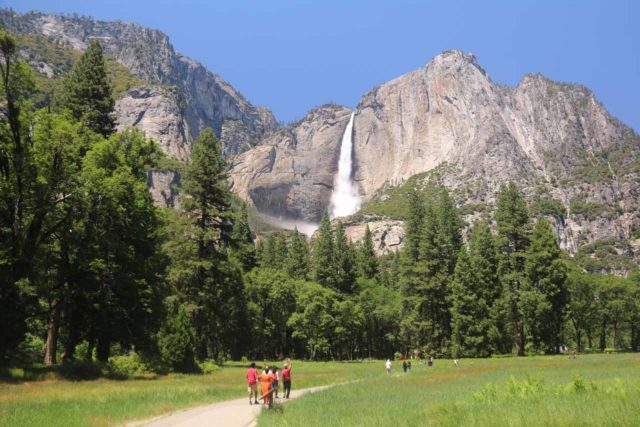
If you proceed further east along the Southside Drive, you can get all the way to Curry Village and Stoneman Meadow (near signpost V22).
Here, you can see the Upper Yosemite Falls from a distance at an angle over the easternmost of the grassy meadows in Yosemite Valley.
For a more intimate experience amongst the meadows fronting Yosemite Falls (especially Cook Meadow), there were plenty of trails and boardwalks linking the Northside Drive with the Southside Drive.
Along this stretch of open terrain, we managed to not only get more perspectives of the iconic waterfall. However, we were also able to do so at our own pace without the stress of trying to find parking or dealing with the traffic.
We were even able to better appreciate Half Dome and North Dome looking to the east, enjoy open looks at Lehamite Falls, and get more photo ops and selfies without worrying too much about other people getting in the way.
If there was a way to experience Yosemite Falls in a relaxed setting, then this would be the method for doing so.
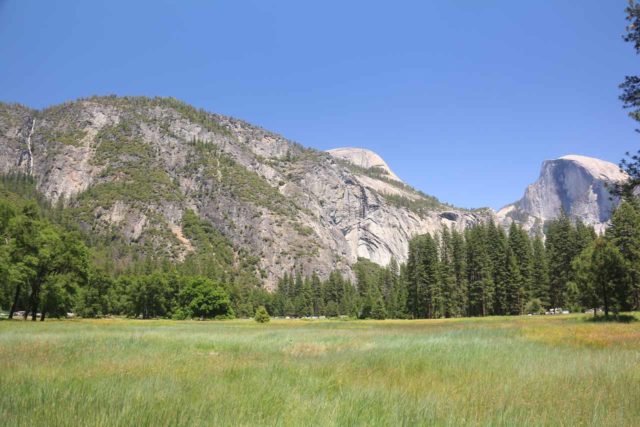
Just to give you an example of a nice flat stroll that we managed to do with the kids, after getting our fill of the base of the Lower Falls, we spontaneously took a trail just east of the Yosemite Lodge through the open Cook Meadow.
We managed to cut all the way across to a bridge over the Merced River near the Yosemite Chapel.
Then, after getting our views of the falls from the Southside Drive, we then hiked back east towards the Stoneman Bridge, where we could get one of the classic views of Half Dome fronted by the Merced River.
Just north of the Stoneman Bridge, we then briefly walked a short distance northwest of the parking lot for Cook Meadow.
Next, we backtracked and cut across a different trail hooking up with the Northside Drive, where we eventually regained our parked car.
This entire loop took us a very leisurely two hours (not counting the extra two hours we had spent at the base of the falls, having a picnic lunch, and spending some minutes at the Yosemite Visitor Center.
View from the summit of Sentinel Dome (Difficulty: 2)
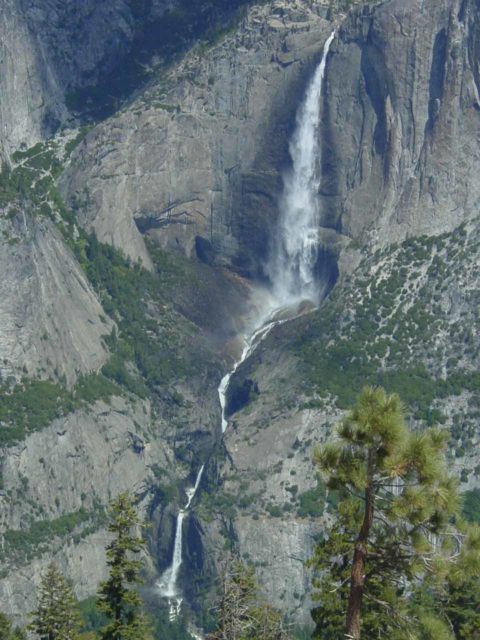
We think the summit of Sentinel Dome is the best place to see the entirety of Yosemite Falls, including its elusive Middle Cascades.
It’s a fairly easy one-mile hike with a steep non-technical scramble (friction pitch) to make the final ascent.
Once at the top, we could look into the ravines that would otherwise be hidden from us at other more well-known vantage points throughout Yosemite Valley and its neighboring cliffs.
Of course, the waterfall isn’t the only reason why we’ve climbed Sentinel Dome.
We were able to get complete 360 degree views of not only Yosemite Valley but also the granite wilderness towards the south (including shapely domes like Mt Starr King) and Tenaya Canyon with part of the Giant Stairway to the east, including the iconic Half Dome.
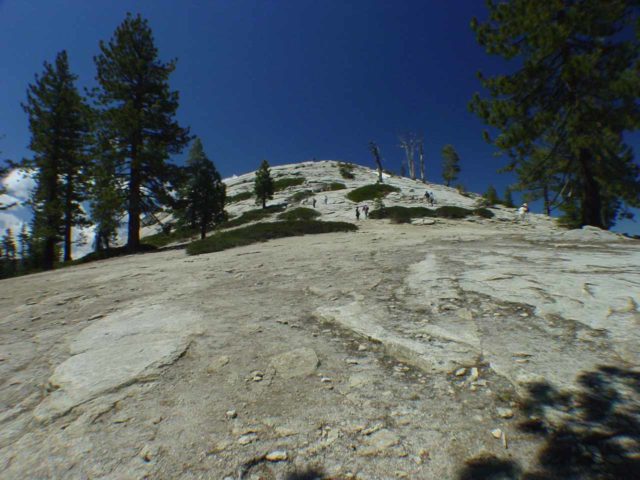
The summit was also once famous having a picturesque lone Jeffrey Pine Tree, which was a popular landmark to frame high country panoramas.
Unfortunately, it eventually died (in the 80s from lightning) and was naturally felled after a thunderstorm some time in 2004 or 2005.
I considered myself fortunate to have photographed it back in 2002 when it was still standing.
The car park for this hike is along Glacier Point Road at signpost G8.
View from Taft Point (Difficulty: 2)
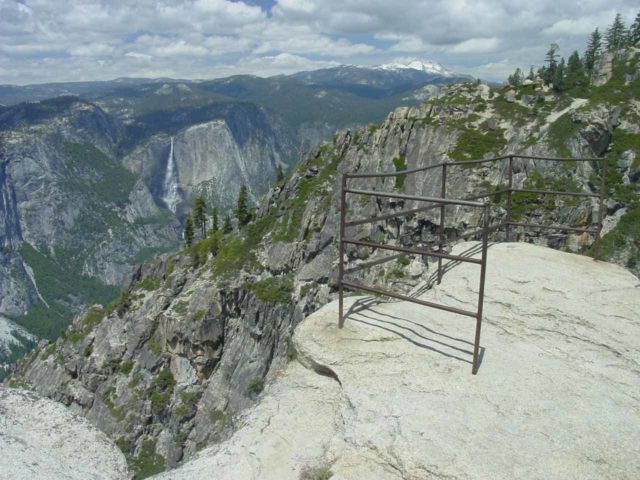
For a little more solitude and a somewhat unusual view of Yosemite Falls, we hiked out to the fissures and sheer vertical drop cliffs at Taft Point.
The lookout was at the end of a 1.1-mile hike from the car park near signpost G8 on the Glacier Point Road (the same one as for Sentinel Dome).
The views from up here definitely induced butterflies because most of the dropoffs did not have railings.
However, the one spot that did have a railing happened to be kind of pointing towards the falls while also giving us a look at the bridge of the nose of El Capitan.
View from Glacier Point and the Panorama Trail (Difficulty: 4)
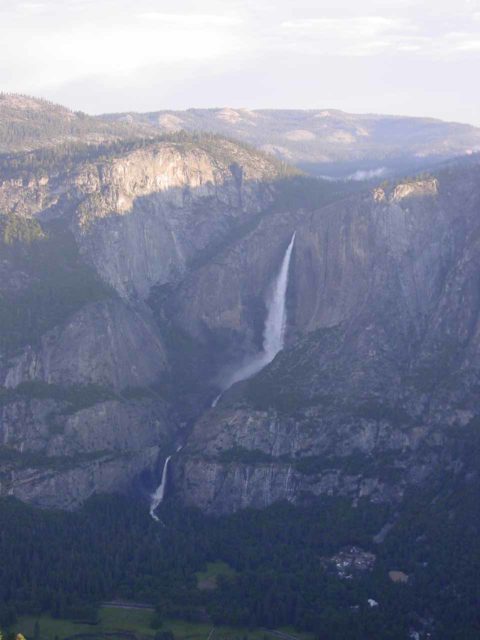
We were able to see Yosemite Falls at an angle at one of the well-touristed lookouts in Glacier Point, which itself sat at the very end of Glacier Point Road (signpost G11).
Glacier Point was also the starting point for the shuttle hike on the Panorama Trail, which allowed us to get close to three major waterfalls (Illilouette Fall, Nevada Falls, and Vernal Fall) while providing more sideways views of Yosemite Falls from a far distance.
The Panorama Trail was an 8.5-mile one-way shuttle hike. It took us the better part of a day, which was why I noted this excursion had a difficulty rating of 4.
It required some coordination where we basically parked one car at the end of the trail at Curry Village.
Then, when we started the hike, we drove up to Glacier Point and left the car there as we did the long one-way hike.
Eventually after recovering the car at Curry Village, we then drove back to Glacier Point to pick up the other car.
Of course, the logistics of having two vehicles and coordinating all the parking and pickups isn’t feasible, one could book a hikers bus.
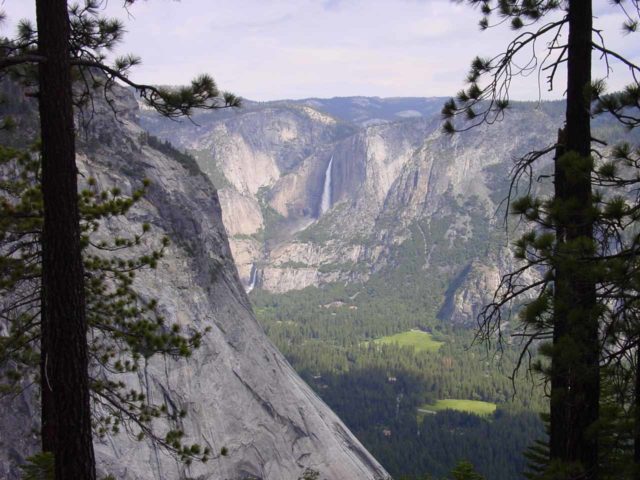
The hikers bus would round up hikers in Yosemite Valley, then drop them off at Glacier Point (or other far-flung trailheads).
Anyways, the Panorama Trail hike was mostly downhill, but there was a fairly long uphill stretch once we crossed the bridge over Illilouette Creek.
That climb ultimately allowed us to reach the Panorama Cliffs overlooking the backside of Half Dome, Liberty Cap, and Nevada Falls.
Finally, the trail descended towards the John Muir Trail where we had the option of descending the rest of the way to the Happy Isles Trailhead via the Mist Trail or the John Muir Trail.
View from the Four-Mile Trail
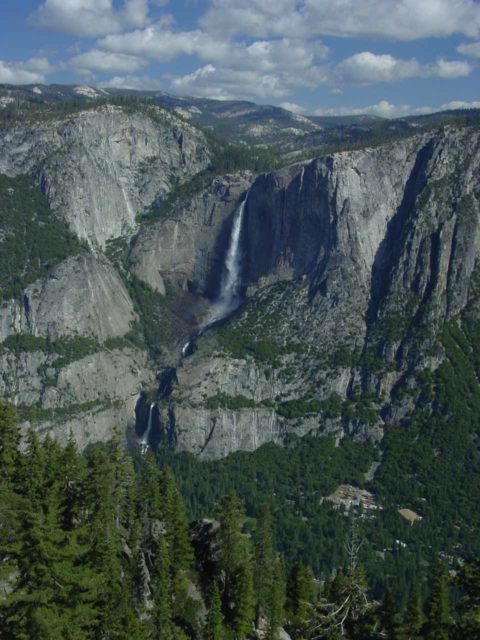
Last but not least, there’s a cliff-exposed view of Yosemite Falls from directly across the valley right on the Four-Mile Trail.
This trail connects Yosemite Valley with Glacier Point.
Technically, it’s longer than four miles each way, and we’ve only walked down from Glacier Point to portions where we could get decent views of the falls before walking back up.
We never did the whole hike.
Nonetheless, I’d imagine it’s a pretty and exhilarating hike, but we were always cognizant of the cliff exposure on this trail.

I remembered confronting my fear of heights on this trail the very first time I was on it way back in 1999, and I recalled how butterflies in my stomach were persistent.
When I revisited this trail in 2005, my fear of heights were not as pronounced so there weren’t as many stomach butterflies.
Still, I’d imagine it largely depends on your fear of heights and hiking experience that will ultimately determine how nervous you might be on this trail.
Authorities
Yosemite Falls resides in Yosemite National Park. For information or inquiries about the park as well as current conditions, visit the National Park Service website.
Related Top 10 Lists
Trip Planning Resources
Nearby Accommodations
This content is for members only. See Membership Options.Featured Images and Nearby Attractions
This content is for members only. See Membership Options.Visitor Comments:
Got something you'd like to share or say to keep the conversation going? Feel free to leave a comment below... Yosemite Falls – Rock Climbing July 25, 2010 6:59 pm - We visited Yosemite falls for the first time on July 6, 2010. What we liked about it most was how close we could get to the falls. There were fantastic rocks to climb along the edge, and my 12 and 15 year old had a wonderful time climbing climbing climbing up along the edge of… ...Read More
Yosemite Falls – Rock Climbing July 25, 2010 6:59 pm - We visited Yosemite falls for the first time on July 6, 2010. What we liked about it most was how close we could get to the falls. There were fantastic rocks to climb along the edge, and my 12 and 15 year old had a wonderful time climbing climbing climbing up along the edge of… ...Read MoreVisitor Reviews of this Waterfall:
If you have a waterfall story or write-up that you'd like to share, feel free to click the button below and fill out the form...No users have submitted a write-up/review of this waterfall


